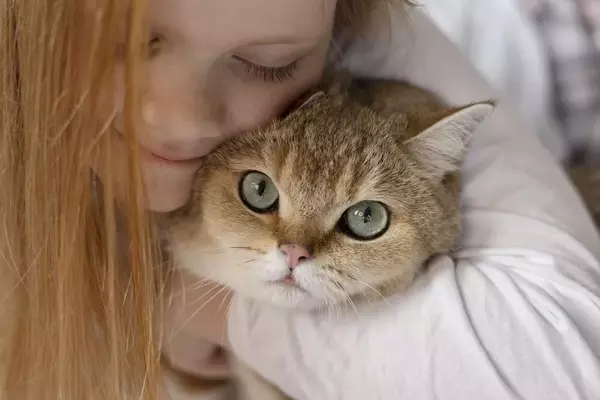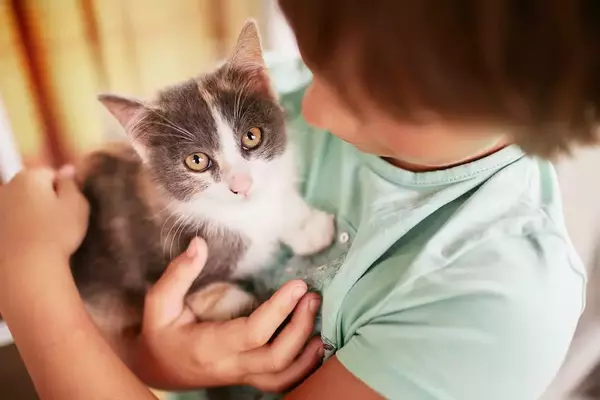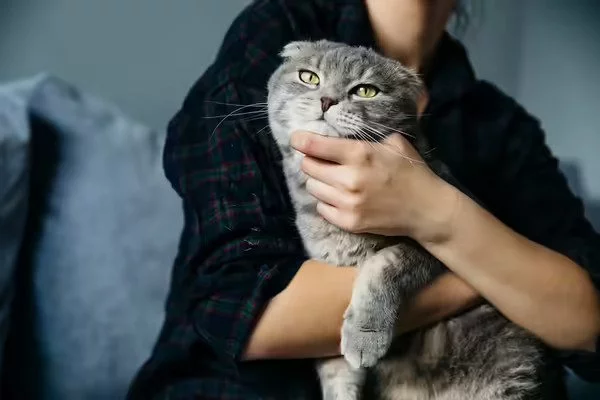The word “domestic shorthair” is quite broad and encompasses a diverse range of cats. It’s a collective label for cats with short hair that don’t belong to a specific breed. This group comprises cats whose ancestry is uncertain or those that are of mixed breeds with a few known breeds in their lineage. A domestic shorthair might display characteristics from any shorthair breed, spanning from the calm British Shorthair to the spirited Siamese. The personality of a domestic shorthair can vary widely, making it a bit unpredictable. However, nurturing proper socialization and care during their early stages is essential for cultivating an affectionate demeanor.
Also Read: Do British Shorthair Cats Like Cuddles?In general, domestic shorthairs tend to be amiable and loving. Much hinges on the cat’s background and the degree of socialization they received during their crucial developmental months. A more affectionate disposition can be nurtured through attentive care and appropriate interactions.

You’ve arrived at this page because you’re intrigued by domestic shorthair cats and have inquiries about them as companions. What defines a domestic shorthair cat? How can I establish a positive rapport with my domestic shorthair? Are domestic shorthair cats affectionate? Why does my cat display aversion toward certain individuals? What leads cats to become unsocial or antisocial? How can I support my domestic shorthair in becoming more sociable? Within this article, I will delve into the psychology of felines and the elements that influence their levels of fondness. Continue reading as I unravel the solutions to all your queries.
Are Domestic Shorthair Cats More Affectionate?
In general, yes. The majority of domestic shorthair cats are quite sociable and will establish a connection with their caregivers. Due to the extensive range of variations encompassed by the term “domestic shorthair,” including a mix of various breeds and diverse personal histories, predicting the exact personality of any individual cat can be challenging.
Even within a single breed, there’s a significant amount of individual diversity in terms of personality. This complexity becomes more pronounced with non-pedigree cats. If you’re particularly concerned about the personality of your new cat, you might consider acquiring a pedigree cat from a breed known for its friendly demeanor. Examples of good breeds include the American Shorthair, British Shorthair, and Tonkinese.

Essentially, proper care is the key to having an affectionate cat. A cat that is well-adopted, healthy, and feels safe will naturally display a friendly disposition. Despite their stereotype of being aloof, cats are indeed social creatures.
Also Read: Are British Shorthair Cats Hypoallergenic?Cats are not inherently solitary creatures. When you bring a cat into your home, you become part of their colony. If they feel secure and trust you, they will regard you much like any other member of their colony.
To cultivate an affectionate nature, proper socialization of kittens is essential. When acquiring a kitten, especially through purchasing rather than adopting, it’s advisable to seek out a reputable cattery. If you’re considering adopting a kitten from a neighbor or another source, it might be more complex.
For the best outcome, it is recommended that kittens stay with their mother for at least 12-13 weeks, but staying for up to 16 weeks is even better. It pains me to witness kittens being separated from their mothers before reaching 12 weeks, as this might lead to them being less robust and feeling less secure. The extended period spent with their mother enables kittens to nurture their sense of curiosity and develop social instincts within a secure and stable setting. Kittens gain valuable insights from older cats, and as a human, it can be quite challenging to replicate these same lessons.
While the kittens are still with their mother, it’s advisable to handle and engage with them occasionally. This exposure to human interaction aids in their acclimatization to companionship and contributes to the development of trust and self-assurance.
It’s of utmost importance to have kittens spayed or neutered at the earliest opportunity. It is important to spay or neuter cats at an early age to support their personality development. The hormones present in an intact cat can lead to various behavioral challenges. Equally significant, leaving a kitten unaltered has implications for their later health. Both male and female cats can encounter health problems due to remaining “entire,” though females might be at a higher risk. Female cats can be severely affected by early and unintended pregnancies. Each reproductive cycle increases the risk of developing certain types of cancer.
Also Read: Female Vs Male British Shorthair CatsHow To Introduce A Domestic Shorthair Kitten?
Assuming everything has gone well, you are now ready to introduce a healthy and well-adapted kitten, between the ages of 12 to 16 weeks, to your home. The initial step is to ensure that your kitten feels secure and at ease in her new environment. Initially, confine your kitten to one room.
A bathroom often serves as an appropriate haven. This room should be relatively undisturbed and isolatable from other animals. It should provide warmth and comfort, equipped with a familiar blanket, bed, or other items. Upon releasing the kitten from the carrier, allow her to investigate her new environment.

Offer some nourishing food options, along with a few tasty treats that are sure to please. Ensure the kitten can access a litter box (by this time, she should be acquainted with using it). In the beginning, approach with extreme gentleness and care. Allow the kitten to approach you on her terms, avoiding sudden grabs or insisting on cuddles and petting. Some kittens might express immediate interest in human interaction, while others might exhibit more reserved behavior initially.
In a day or two, your young cat should begin to feel more at ease. It’s now acceptable to let her begin to venture into other areas of your home. Be sure to communicate to everyone in your household that a fresh kitten requires delicate handling. If you have other animals as companions, it’s best to delay their introduction for a few more days. When introducing different animals, it’s wise to do so gradually, initially using a partition between them. I prefer to initiate the initial meeting when everyone is having a meal, as this establishes a favorable connection.
Also Read: 10 Important Facts To Know About The British Shorthairs as PetsIt’s crucial to avoid introducing your kitten to animals that may be perceived as prey, such as birds, rabbits, mice, rats, or other similar creatures. Unless in rare cases, your kitten will not be easily convinced that these animals are not food but actually her friends. To prevent any unfortunate incidents, it’s best to keep them separated from each other at all times.
How To Introduce An Adult Domestic Shorthair?
There are advantages and disadvantages to adopting an adult cat. While you won’t have the same degree of influence on an adult cat’s development as you would with a kitten, Conversely, fully-grown cats are generally simpler to look after overall. They tend to be more composed and less inclined to engage in mischievous behavior.
When introducing your new adult cat, follow a similar approach to that of a kitten. Even confident cats might need a gradual introduction. Unfamiliar things can disturb a cat, which might result in feelings of anxiety. Provide your cat with ample support and motivation, giving them treats and making sure that their initial interactions with other household members are pleasant. Keep in mind that first impressions can have a lasting impact on cats.

If, for any reason, your cat has not undergone spaying or neutering, it’s advisable to have this procedure carried out promptly. Even after a cat has reached sexual maturity, many behavioral problems can improve once they are spayed or neutered. Neutering a male cat can help prevent issues like spraying or aggressive behavior displays. For female cats, spaying is a must. Female cats can become quite challenging to manage when they’re in heat, and as mentioned earlier, there are significant health risks associated with not spaying them.
Also Read: How Much Does A British Shorthair Cat Cost (US/UK/AU)?Domestic shorthairs that have been rescued might struggle with trauma or they might having attachment challenges. To support these cats, it’s beneficial to establish a safe and cat-friendly setting. Ensure there are secure spots for the cat to retreat to and observe from, like cat hideouts and elevated shelves for perching. Avoid pressuring a nervous cat for physical contact or petting. Instead, provide affection gently and cautiously, enabling the cat to leave the interaction if it becomes overwhelming.
If you want to gain the trust of a shy cat, try offering them treats and being kind to them. Be patient, as it may take some time. Once their trust is earned, you can expect to be their favorite person for a long time.

Hi, this Sienna Metts, the purr-fect authority in the captivating world of feline wisdom. I live in White Plains, NY. With years of experience in studying and understanding the behavior, health, and unique traits of different cat breeds, I have earned a well-deserved reputation as a feline connoisseur. Through my articles, I’ll be sharing captivating stories, practical advice, and expert tips on topics ranging from breed characteristics, care and eating guidelines to training techniques and holistic health solutions.


















